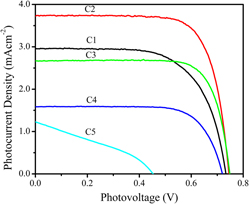Article contents
Dye-sensitized solar cells based on ZnO nanoneedle/TiO2 nanoparticle composite photoelectrodes with controllable weight ratio
Published online by Cambridge University Press: 30 October 2012
Abstract

To possess the merits of both building blocks, i.e., the rapid interfacial electron transport of ZnO nanoneedles (NNs) and the high surface area of TiO2 nanoparticles (NPs), the ZnO NN and TiO2 NP composite photoelectrodes were prepared with controllable weight ratio. The dye-sensitized solar cell (DSSC) prototypes were fabricated based on this composite photoelectrodes, and the photoelectrical properties have been systematically studied. The results indicate that the composite cells achieve higher power conversion efficiency compared to pure TiO2 NP cells by rational tuning the weight ratio of ZnO NNs and TiO2NPs. The DSSC with 1 wt% ZnO NNs yields the highest η of 5.16%. It is elucidated by the interfacial electron transfer of DSSC with different weight of ZnO NNs using the electrochemical impedance spectra. And it is found that the DSSC with 1 wt% ZnO NNs displays the fastest interfacial electron transfer.
Information
- Type
- Articles
- Information
- Copyright
- Copyright © Materials Research Society 2012
References
REFERENCES
- 4
- Cited by

